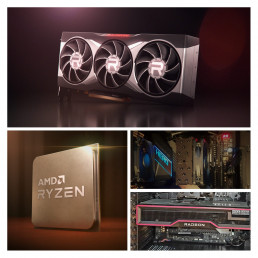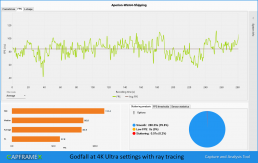AMD unveiled new Zen 3 Ryzen 5000 processors (codenamed Vermeer) and a new lineup of Radeon RX 6000 series (Big Navi) graphics cards for desktops in two online events held on October 8 and 28, 2020.
AMD proved last year that it could be highly competitive, with its Ryzen 3000 series (codenamed Matisse) processors and Radeon RX 5000 series (Navi) graphics cards establishing themselves as excellent all-rounders in both cost and performance terms. The success of these helped AMD’s computing and graphics division grow 31% year on year to reach a value of $1.7 billion, as reported in the company’s latest financial results.
AMD claims that its new Vermeer CPUs are the fastest in the game and that its Big Navi Series graphics cards deliver powerhouse performance. Having the fastest gaming platform is a huge boost to brand prestige and perception, and a very useful marketing tool. In this review, we test AMD’s claims about the Ryzen 9 5900X and the Radeon RX 6800 XT.
New Features
Cache Is the Key
AMD has leveraged cache to boost the performance of the new-generation CPUs and GPUs. Although the amount of cache used in Zen 3–based Ryzen CPUs is the same as the previous Zen 2 CPUs, architectural modifications have greatly contributed to performance enhancements.
The previous Zen 2 architectures used two core complexes (CCXs) per compute die (CCD). The Zen 3 architecture, however, makes use of only one CCX that contains up to eight cores (Zen 2 CCXs could only contain up to four cores). This means that each Zen 3 CCX has access to the entire L3 cache available on one CCD — this reduces communication latencies between the cores, boosting performance in the process.
The RDNA2-based Big Navi Radeon GPU, on the other hand, has been given a major on-chip cache uplift of 128MB. This larger cache, which AMD has dubbed “Infinity Cache”, improves efficiency and performance by reducing the frequent access to video RAM (VRAM).
AMD Smart Access Memory
AMD’s Accelerated Processing Unit (APU) concept, which is a combination of a Ryzen processor and Radeon GPU, can improve performance by allowing the memory in the GPU to be used alongside the memory within the CPU. The interaction between the two sets of memory has also been strengthened by AMD’s new Smart Access Memory (SAM) technology.
SAM allows data to be transferred between the CPU and GPU via PCIe bandwidth. It also enables the CPU to have full access to GPU VRAM. This technology is generally expected to improve efficiency.
Ray Tracing
AMD’s support for ray tracing was evident in the launch of the RDNA2-based Radeon 6000 series GPU. The red team updated graphics features to meet the DirectX 12 Ultimate standard, which has four new features (namely DirectX Raytracing, Variable Rate Shading, Mesh Shaders and Sampler Feedback). In addition, AMD added a hardware component (Ray Accelerator) to every compute unit to enhance the ray tracing experience, which in turn is supported by the inclusion of the 128MB Infinity Cache.
Overclockability
RAM
AMD officially supports DDR4 memory with frequencies up to 3200MHz. Using RAM at higher frequencies pushes the clock speeds at which the unified memory controller (UMC), the I/O hub controller and the infinity fabric (IF) operate. According to AMD, the fabric overclocking tolerance is shifting towards 2000MHz with the Ryzen 5000 Series.
The company feels confident that even more users will be able to obtain these speeds with forthcoming optimisations. We were able to achieve 1933MHz tolerance with a 3866MHz RAM kit. We were informed to hang tight for a new AMD Generic Encapsulated Software Architecture (AGESA) library. This means the use of DDR4 4000MHz RAM will be possible, but not guaranteed.
CPU
Precision Boost Overdrive automatic overclocking, through motherboard BIOS software or tools such as AMD Ryzen Master, enables Ryzen chips to be overclocked beyond their rated specifications. Users who are new to overclocking or those who wish to have a simplified experience can also use the AutoOC feature. We were able to overclock all 12 cores to 4.675GHz.
Although overclocking has been made easy, AMD does not officially support overclocking, and pushing a chip beyond its rated specifications may void its warranty. Additionally, the overclocking gains are not worth the energy consumption, especially in gaming. A user may also lose the single-core boost, which normally reaches 4.95GHz.
GPU
Rage (named after the ATI Rage series) is a performance tuning preset in the Radeon Software Adrenalin 2020 Edition. It raises power and fan-speed limits to take advantage of any extra headroom available in the GPU and deliver the greatest performance. Using this preset, the RX 6800 XT can be overclocked to 2310MHz. In our tests, we were able to squeeze 100MHz more from the RX 6800 XT by using a third-party app.
We expect AMD partner cards to have even more headroom for overclocking. However, we see little benefit from risking the card’s life and warranty for 10% more performance. The Radeon RX 6800 XT already has incredibly high frame rates, as our gaming benchmarks will show.
The Test Platform
Our test system combined the AMD Ryzen 9 5900X and Radeon RX 6800 XT with a 16GB DDR4 3200MHz CL16 RAM kit, a 1TB M.2 NVMe SSD and an AMD X570 ATX gaming motherboard.
Synthetic Benchmarks and Productivity Performance
PCMark 10 features a comprehensive set of tests that cover the wide variety of tasks performed in the modern workplace. The tasks tested include web browsing, videoconferencing, spreadsheet and word-processing workloads, photo and video editing, and rendering and visualisation. The gaming test group focuses on real-time graphics and physics. The 10,908 score the platform achieved was better than 99% of all results.
Realbench uses open source applications (such as GIMP for image editing, Handbrake h.264 for video compression and LuxMark for rendering) to simulate real-world performance. The Heavy Multitasking test runs all tests together at once. The test platform achieved a final score of 287,556, which was 39.1% higher than a previously tested system featuring the Ryzen 9 3900X and the Radeon RX 5700 XT. The rendering performance was also 86.3% faster.
In addition, we used Blender’s bmw27 benchmark to test the rendering performance of the graphics card, which took 39s to accomplish. This result ranks in the top 9% of benchmarks running the same scene.
The Ryzen 9 5900X scored 665.4 points in the CPU-Z single-thread benchmark, which was 25.5% higher than Ryzen 9 3950X. The Ryzen 9 5900X also scored 621 points in the Cinebench R20 testing suite, higher than the 507 points achieved by the Ryzen 9 3900X.
3DMark Port Royal is a dedicated real-time ray tracing benchmark for gamers. The system’s score of 8,784 was better than 78% of all results. However, this would have been higher but for our use of standard settings and no overclocking. In addition, the 3DMark Time Spy 4K score of 8,066 was better than 94% of all results.
Outstanding Generational Leap in Gaming
The AMD Ryzen 9 5900X and Radeon RX 6800XT test platform achieved an average of 176 frames per second (fps) running Shadow of the Tomb Raider at 1080p and the highest graphical settings — 74% better than the fps achieved by the Ryzen 9 3900X paired with RX 5700 XT. That is an amazing generational leap.
PlayerUnknown’s Battlegrounds (PUBG) and Total War Saga: Troy run at 129fps and 86fps respectively, while Dirt 5 runs at 80fps with ray tracing enabled at the highest settings at 1440p.
4K Performance
In general, running other games such as Resident Evil 3 and Monster Hunter World at 4K saw performance improvements of over 80% compared with the 5700XT. The platform also reduces board power consumption and thermals at a smaller physical size than the prior generation, making it a true drop-in replacement that is easier on the system and draws less power from the mains.
Shadow of the Tomb Raider ran with high-quality ray traced shadows at 44fps on average, while Godfall — a game that uses Unreal Engine 4 and the DirectX12 Ultimate application programming interface —ran at an average of 84fps in 4K with ray tracing enabled.
Microsoft Flight Simulator 2020 had one of the most impressive 4K performance improvements on the test platform, which ran the game at 40–55fps on ultra settings (the game ran at less than 20fps on a previous testing bench). In fact, going for a 30fps limit on a fixed-rate monitor results in the internal upscaling (called render scaling) kicking in, which then uses multiframe interpolation to deliver crisper visuals — which is an amazing feature, and results in a smoothly playable game.
The 6800XT is easily able to maintain 60+fps during these challenging workloads. However, the experience will be a little less stunning on 4K monitors, which still tend to be restricted to refresh rates of 60Hz and lower due to the limitations of the HDMI standard.
Since 4K monitors have made up less than 3% of all monitor shipments to the EMEA region for several years, and because the number of 4K monitors that support Freescale and 120Hz refresh rates are minimal, the 6800XT is an ideal match for the installed base.
Availability — The Elephant in the Room
Industry dynamics have been unpredictable in 2020, with most people staying at home and restricted from consuming their usual forms of entertainment. However, interest in gaming has grown hugely during the year.
Despite the dour predictions of many PC vendors in late 2019, demand for PCs and laptops has surged in 2020. At the same time, devices have long production lead times once manufacturing forecasts and decisions are made — usually, it can take six months or more to get products into the market and into consumers’ hands.
The new generation of GPUs offers greatly improved price-to-performance ratios. As a result, the latest high-performance gaming kits (i.e., CPUs plus GPUs) tend to sell out in minutes when launched. This creates shortages, and resupplies of inventories may be inadequate to keep up with demand.
This unforeseen demand has put AMD and its competitors between a rock and a hard place — should these vendors launch limited supplies of products early and bring in much needed revenue, or wait longer to build up inventories while tying up and risking substantial amounts of capital?
With the holiday period approaching, no company can really afford to wait to satisfy the entire market demand; rather, they must choose the best compromise for their businesses and profitability goals. At the same time, vendors need to be aware of the inherent weaknesses with early launch strategies. For example, bots and scalpers can arguably capture significant portions of early supplies. This will remain a substantial problem going forward, and vendors will need to address them with novel strategies.
IDC Opinion and Conclusion
AMD is raising the bar generation after generation, going from introducing affordable mainstream 1080p gaming with the RX 400/Ryzen 1000 series to spearheading high-end 1440p/4K gaming with the RX 6000/Ryzen 5000 series. It is the only company to have made such generational leaps on the CPU/GPU fronts in just four years.
AMD’s gaming platform is not only making 1440p mainstream, but also helps make high frame rates of 120–140Hz become the norm. It also makes 4K gaming at 60+fps with the highest possible graphical settings realistically achievable.
AMD’s “Where Gaming Begins” slogan suggests that the company is fully focused on taking gaming seriously. Indeed, during the RDNA 2 launch event, the company deliberately mentioned that RDNA 3 architecture is being designed. The company promised additional optimisations in future, with a new AGESA library coming out soon and a “FidelityFX Super Resolution” currently in development.
In conclusion, AMD offers high-end gaming experiences at high frame rates and resolutions with almost no compromises, which brings the power of choice back to gamers.
Read more:
Vermeer: AMD Zen 3 Ryzen 5000 Series Desktop Processors
If you want to learn more about this topic or have any questions, please contact Mohamed Hefny, Malini Paul, or Andrew Buss, or head over to https://www.idc.com/eu and drop your details in the form on the top right.








